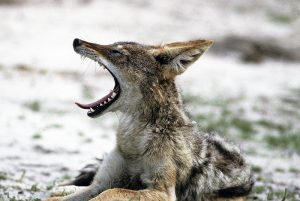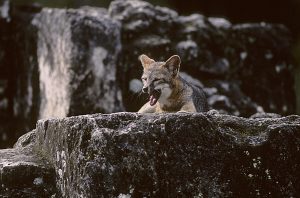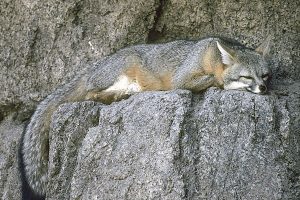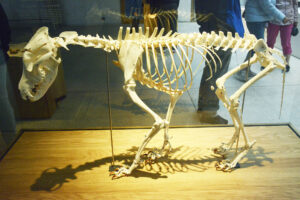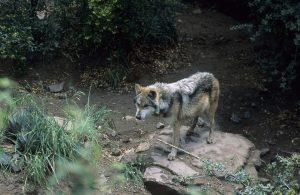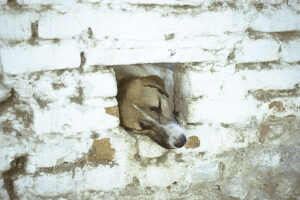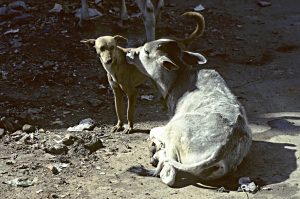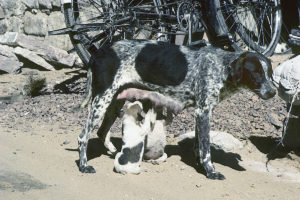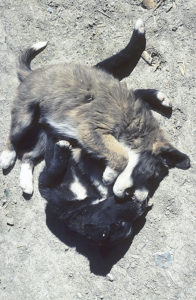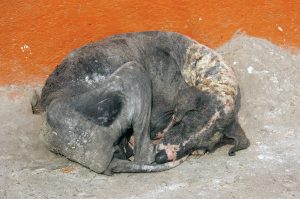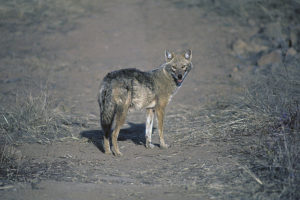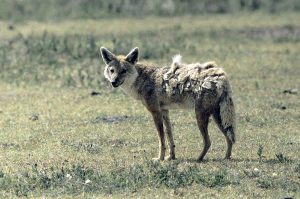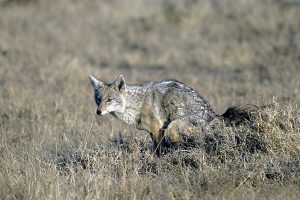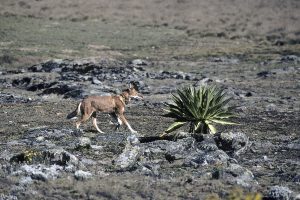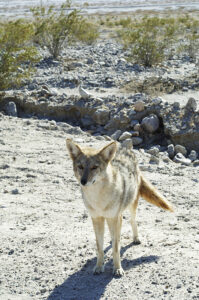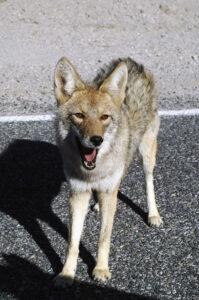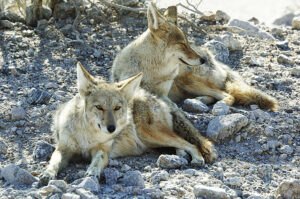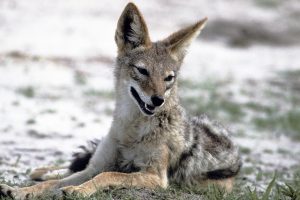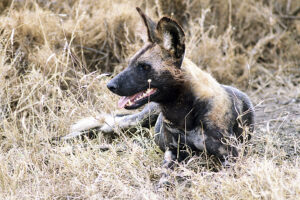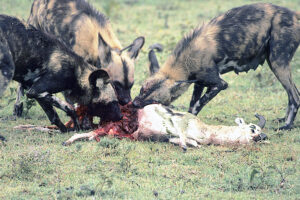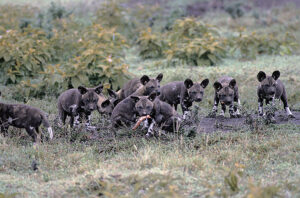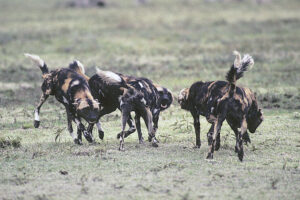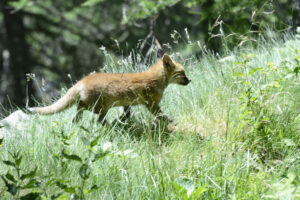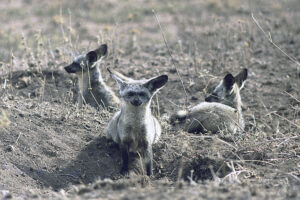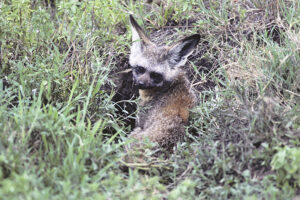Dog family
Andean fox (Lycalopex culpaeus), resting near the Miscanti y Miniques Lakes, Atacama, Chile. (Photo copyright © by Kaj Halberg)
This woman is walking her dog on a beach at Mendocino, California. (Photo copyright © by Kaj Halberg)
An African hunting dog bitch (Lycaon pictus) regurgitates meat for her pups. (Photo copyright © by Kaj Halberg)
Yawning black-backed jackal (Lupulella mesomelas), Hwange National Park, Zimbabwe. (Photo copyright © by Kaj Halberg)
Wall painting in the Death Temple of Queen Hatsepsut, Luxor, showing Anubis, the Egyptian god of embalming, who is often depicted with the head of a jackal. (Photo copyright © by Kaj Halberg)
The dog family (Canidae), comprising about 35 species, includes domestic dogs, wolves, jackals, hunting dogs, foxes, and many other dog-like animals. About 50 million years ago, a group of carnivores split into two groups, the cat-like Feliformia and the dog-like Caniformia.
The latter evolved into a large number of families, of which the Canidae, about 12 mio. years ago, split into three groups:
Canini includes wolf-like dogs, and South American dogs and foxes.
Vulpini includes typical foxes, bat-eared fox (Otocyon megalotis), and raccoon dog (Nyctereutes procyonoides)
Two foxes of the genus Urocyon seem to have split out at a very early stage (Lindblad-Toh et al. 2005). Modern taxonomists do not include these two species in Canini or Vulpini.
Urocyon Ancient dog lineage
Urocyon cinereoargenteus Grey fox
This species and its close relative, the island fox (U. littoralis), seem to form the most ancient clade within the dog family. Whereas the latter is restricted to 6 of the 8 Californian Channel Islands, the grey fox is widely distributed, from southern Canada south through Central America to Columbia and Venezuela.
The grey fox is common among the Mayan ruins of Tikal, Guatemala. (Photo copyright © by Kaj Halberg)
Sleeping grey fox, Tucson Desert Zoo, Arizona. (Photo copyright © by Kaj Halberg)
Canini Wolf-like dogs, and South American dogs and foxes
Canis Wolf-like dogs
In later years, following a number of genetic studies, this genus has been the cause of much confusion and has been revised several times. As of 2022, the genus contains between 5 and 11 species. All authorities now recognize 5 species: grey wolf (C. lupus), coyote (C. latrans), African golden wolf (C. lupaster), Ethiopian wolf (C. simensis), and golden jackal (C. aureus). Others also regard one or more of the following as separate species: domestic dog (below), dingo (below), red wolf (C. rufus), eastern wolf (C. lycaon), Indian wolf (C. pallipes), and Himalayan wolf (C. himalayensis).
Recently, two species of jackals, the black-backed (formerly C. mesomelas) and the side-striped (formerly C. adustus), have been moved to a separate genus, Lupulella (below).
Canis lupus Grey wolf
The grey wolf, or simply wolf, is widespread in Europe, Arabia, the Middle East, and northern parts of Asia, as well as in North America. About 37 subspecies are recognized, some of which may merit specific status. The total number of wolves is estimated at 300,000.
Between 1700 and 1900, the wolf was eradicated in most of Europe. In southern England, it had been largely eradicated by the end of the 1400s through hunting and using traps, and in the 1500s, wolves were only found in Scotland. The last wolf on the British Isles was killed around 1680.
In Germany, the wolf was eradicated in the 1700s, and the last Danish wolf was killed in 1813. It returned to Germany from Poland in the 1990s, and the first pair was established by 2000. Since then, it has spread considerably, and the first Danish wolf in 199 years was found dead in 2012.
My encounter with a wolf is described on the page Travel episodes – Iran 1973: Car breakdown at the Caspian Sea.
The skeleton of the wolf, which was found dead in Thy, Denmark, in 2012. It is exhibited in the museum of National Park Thy in Nr. Vorupør. (Photo copyright © by Kaj Halberg)
In this wolf trap in Ladakh, north-western India, a goat or a sheep would previously be tied as bait. Once the wolf jumped inside to kill the animal, it was unable to climb out again, whereupon the villagers would stone it to death. (Photo copyright © by Kaj Halberg)
Despite being a subject of hatred throughout the world, the wolf is an iconic animal, which is often depicted. This truck in Cariari, Costa Rica, is decorated with a painting, depicting a wolf, a sun, and – a truck. (Photo copyright © by Kaj Halberg)
The Mexican wolf, ssp. baileyi, is the most endangered North American subspecies of the grey wolf. It was extirpated in the wild in the United States around 1950 due to a combination of hunting, trapping, poisoning, and digging out pups from dens. In 1976, the American and Mexican authorities collaborated to capture all Mexican wolves remaining in the wild. Four males and one pregnant female were captured alive to initiate a captive breeding program. In 1998, captive-bred Mexican wolves were released into suitable areas in Arizona and New Mexico. As it turned out, this program was a success, and in 2017 there were 143 of these endangered wolves living in the wild, and 240 in captivity (Nie 2003, Heffelfinger et al. 2017).
Mexican wolf, photographed in Tucson Desert Zoo, Arizona. (Photo copyright © by Kaj Halberg)
Canis lupus ssp. familiaris Domestic dog
Most authorities consider the domestic dog a subspecies of the wolf, whereas others regard it as a separate species, C. familiaris.
Dogs were first tamed at least 30,000 years ago, when Stone Age people trained wolves to assist them in hunting. Since then, the dog has been the most valuable companion of Man within the animal kingdom. The domestication of the dog is dealt with in detail on the page Animals: Animals as servants of Man, which also shows numerous dog breeds, and Man’s usage of dogs.
Two types of dogs, which descended from the ancestral dog, are so different from other dogs that they have been given subspecific status: the Australian Dingo (C. l. dingo) and the African Basenji (C. l. basenji). They differ from other dogs in that they cannot bark, and they come into oestrus only once a year, as opposed to twice or more annually in other dogs. They also both lack a distinctive body odour.
Genetic evidence indicates that the Dingo originated from East Asian domestic dogs. It was introduced to Australia about 4,000 years ago by seafaring tribes, and today feral populations live in most of the continent, barred from access to the south-eastern part of the country by a so-called ‘dingo fence’. Today, it is the largest terrestrial predator in Australia, as the indigenous thylacine, or Tasmanian wolf (Thylacinus cynocephalus), was extirpated by farmers in the 1900s. Dingos are often a threat to livestock, but at the same time they benefit farmers, as they mainly prey on rabbits, kangaroos, and rats – three major pests in Australian farming.
The Basenji is said to have originated in the Congo Basin in West Africa. Dogs, resembling modern Basenjis are depicted in Egyptian tombs, sitting with pricked ears and tightly curled tails, just as they do today. Dogs of this type were originally kept in Egypt for hunting small game (Dollman 1937).
Neolithic people domesticated wolves to assist them when hunting, and possibly also during warfare. This Bronze Age petroglyph at Fossum, Bohuslän, Sweden, may depict men in battle, accompanied by dogs. (Photo copyright © by Kaj Halberg)
One of the first dogs to be domesticated by humans was the Indian pariah dog, also called Desi dog, which is native to the Indian subcontinent. This dog is medium-sized, with short coat, pointed muzzle, and often curved tail. Most pariah dogs are various shades of brown, ranging from dark-brown to reddish-brown, or sometimes black, and some are pied.
This breed was named by the British Raj, after the Pariah tribe near Chennai, derived from the Hindi word pahi (‘outsider’), which was Anglicized to pariah or pye. The alternative name Desi dog is derived from Urdu desi (‘native’).
Pariah dog, sleeping with her pups in a basket, Bodhgaya, Bihar. (Photo copyright © by Kaj Halberg)
Pariah dog, watching life from a doorway, Varanasi. (Photo copyright © by Kaj Halberg)
This pariah dog is sleeping with its head sticking out through a hole in a wall, Udaipur, Rajasthan. (Photo copyright © by Kaj Halberg)
At dawn, these pariah dogs are still asleep on the shore of the Ganges River, Varanasi. (Photo copyright © by Kaj Halberg)
Friends. – Zebu calf, sniffing a pariah dog, Rajasthan. (Photo copyright © by Kaj Halberg)
The Iban hunting dog is another dog breed, which was tamed at an early stage. It was utilized as a watch dog and hunting dog by various Dayak peoples of Borneo. These dogs were still much in use during hunting trips until around the 1990s. Since then, hunting in Borneo has largely been abandoned.
My adventures among Punan tribals are related on the page Travel episodes – Borneo 1975: Canoe trip with Punan tribals.
Portrait of an Iban hunting dog, Sarawak. (Photo copyright © by Kaj Halberg)
This picture from 1975 shows Punan tribals, travelling by canoe up the Ba River with their dogs. (Photo copyright © by Kaj Halberg)
When mating, the head of the male dog’s penis begins to swell, making it impossible for him to withdraw his organ. Male and bitch may be attached to each other for up to 30 minutes, which is called the tie phenomenon. This prevents other males from mating with the bitch, and thus greatly enhances the chances that this particular male’s semen will fertilize the eggs.
Copulating pariah dogs, Puri, Odisha (Orissa), India. (Photos copyright © by Kaj Halberg)
The gestation period of dogs varies between 58 and 68 days, depending on size. Humans often begin to wean pups, when they are ca. 8 weeks old, but if their mother allows them, pups will suckle much longer.
Stray dog, suckling her pups, Jodhpur, Rajasthan, India. (Photo copyright © by Kaj Halberg)
When playing, pups learn many skills. These were encountered in Gyantse, Tibet. (Photo copyright © by Kaj Halberg)
The eye colour of the domestic dog is usually brown, whereas the wolf often has yellow eyes. Occasionally, dogs with blue or whitish eyes are seen.
This dog in Kathmandu, Nepal, has a brown and a whitish eye. (Photo copyright © by Kaj Halberg)
Dogs have very few sweat glands, primarily on the paw pads, and they get rid of excess heat by panting.
Panting Beagle, encountered in Chingshuian Recreation Area, Taiwan. (Photo copyright © by Kaj Halberg)
Sarcoptic mange is a disease among dogs, caused by mites of the species Sarcoptes scabiei, which tunnel through the skin, causing intense itching. The hair loss mainly stems from the dog scratching itself to relieve the irritation.
This pariah dog in Varanasi, India, is almost hairless due to a severe attack of sarcoptic mange. (Photo copyright © by Kaj Halberg)
Many dogs are quite intelligent and can learn many tricks.
Kathmandu, Nepal. (Photo copyright © by Kaj Halberg)
Canis aureus Golden jackal
Like the coyote (below), the golden jackal is a highly adaptable and successful animal, living in a large variety of habitats. As it often takes domestic fowl and lambs, it is much persecuted, but is nevertheless still expanding its range. Today, seven subspecies are distributed from Southeast Asia (Myanmar and Thailand), westwards through India, Sri Lanka, The Middle East, and the Arabian Peninsula, the Balkans, Austria, and parts of Germany, and since 2015, several animals have been reported as far north as Denmark.
In north-western India, the ranges of the nominate race of the golden jackal, aureus, and the Indian jackal, subspecies indica, overlap.
Golden jackal, Ranthambhor National Park, Rajasthan. (Photo copyright © by Kaj Halberg)
On an extremely hot April day, this pair of golden jackals enjoy a bath in a waterhole, Sariska National Park, Rajasthan. (Photo copyright © by Kaj Halberg)
Canis lupaster African golden wolf
Previously, this animal, also known as C. anthus, was regarded as a subspecies of the golden jackal (above), and one subspecies, lupaster, was classified as a subspecies of the grey wolf. Recent DNA analyses have revealed that it is quite distinct from both the golden jackal and the grey wolf.
It is distributed in the northern parts of Africa, from Morocco eastwards to Egypt, southwards to Senegal and northern Tanzania. It is a highly adaptable species, which thrives in savannas as well as quite dry deserts. In the Atlas Mountains, it has been found up to an altitude of 1,800 m.
This golden wolf in the Ngorongoro Crater, Tanzania, has a somewhat ‘woolly’ appearance, as it is shedding its fur. (Photo copyright © by Kaj Halberg)
Golden wolf, marking territory by urinating, Serengeti National Park, Tanzania. (Photo copyright © by Kaj Halberg)
Canis simensis Ethiopian wolf
The Ethiopian wolf, also called Abyssinian wolf or Simien fox, only lives in the highlands of Ethiopia, at altitudes between 3,000 and 4,500 m. Unlike most other larger canids, which feed on a large number of prey species, this red and white animal is highly specialized, feeding almost entirely on alpine rodents.
Due to human encroachment and competition from feral domestic dogs, it has become Africa’s most endangered carnivore. As of 2011, it was restricted to seven montane areas, counting about 400 adult animals, more than half of which were found in Bale Mountains National Park.
Ethiopian wolf, Bale Mountains National Park. This animal is tagged with a radio collar, making it possible to track its movements. The plant to the right is Lobelia rhynchopetalum. (Photo copyright © by Kaj Halberg)
Canis latrans Coyote
The coyote, or prairie wolf, is common and widespread in the major part of North America, southwards through Mexico to Panama. Due to its adaptability and its varied diet, which consists of smaller mammals, birds, reptiles, amphibians, fish, invertebrates, and occasionally fruits and vegetables, it has been able to expand into urban areas, despite being persecuted in many places. 19 subspecies have been described.
The name coyote is a Spanish corruption of the Nahuatl word for this animal, coyotl.
The cleverness of the coyote is reflected in the mythology of many indigenous peoples of North America. A wizard named Coyote is one of the characters that most often appears in myths and legends, often as a trickster. He is usually depicted as man-like, often with some coyote features, such as fur, pointed ears, yellow eyes, a tail, and claws.
According to one myth among certain Pacific peoples, Coyote was once playing with his eyes, throwing them up into the air and catching them again. However, he was surprised by the eagle god, who snatched the eyes and flew away with them. Being unable to see, Coyote created new eyes from buttercup flowers (Ranunculus), for which reason these flowers, among some tribes, were known as Coyote’s Eyes.
When my companion Lars Skipper and I were driving along a road in Death Valley National Park, California, a coyote pair was standing in the middle of the road, waiting for someone to stop and feed them. This habit is unfortunately only too common in the United States, as many people find these dogs cute. As we are opposed to feeding wild animals, we didn’t give them anything, and soon they retreated to the shade under a bush.
(Photos copyright © by Kaj Halberg)
Sign, discouraging people from feeding coyotes, Tucson Mountain Park, Arizona. (Photo copyright © by Kaj Halberg)
Lupulella
In 2017, genetic research concluded that two species of jackals, the black-backed (below) and the side-striped (L. adusta), were only distantly related to members of the genus Canis (above), and, consequently, they were moved to a separate genus.
Lupulella mesomelas Black-backed jackal
The black-backed, or silver-backed, jackal is quite common in two widely separated areas in Africa. The nominate subspecies is distributed in southern Africa, from southern Angola, south-western Zambia, Zimbabwe, and southern Mozambique southwards to the Cape Province of South Africa, whereas subspecies schmidti is found from extreme south-eastern Sudan, Eritrea, and Ethiopia southwards to central Tanzania, westwards to Uganda.
Resting black-backed jackal, Hwange National Park, Zimbabwe. (Photo copyright © by Kaj Halberg)
The black-backed jackal is also called silver-backed jackal due to the large number of white hairs on the blackish back. This picture is from the Ngorongoro Crater, Tanzania. (Photo copyright © by Kaj Halberg)
Lycaon pictus African hunting dog
The African hunting dog is the only member of the genus Lycaon. The scientific name is derived from the Greek lykos (‘wolf’) and the Latin pictus (‘painted’), thus ’the painted wolf’. However, it is only distantly related to the wolf, but the term painted is a most suitable description of it. The snout is always black, and the tip of the tail always white, but otherwise their pelt varies tremendously, showing patterns of various shades of brown, black, white, and yellowish. Some individuals are almost black, others sand-coloured, and no two animals are alike.
Hunting dogs live in packs, the size of which varies enormously, from 2 to about 25 members – usually between 6 and 10. Most of the year, these animals are nomads, roaming savannas and woodland in search of prey. The hunting area of a pack may exceed 4,000 km2.
As a rule, a bitch gives birth to 8 to 16 pups. She only has 12 or 14 teats, and if the litter is larger the pups must suckle in turn. Under normal circumstances, the other dogs in the pack have no difficulty in supplying enough food for the mother and her pups. During his studies, biologist Hugo van Lawick noticed a peculiar behaviour, when he watched a dominant female suckling a mother dog of a lower status (Lawick & Goodall 1970). The desire for suckling seems to be quite strong.
Formerly, the African hunting dog was distributed throughout sub-Saharan Africa but has disappeared from much of its former range. This decline is due to habitat fragmentation, persecution from humans, and a very contagious viral disease, which has killed entire packs all across East Africa. In 2016, the total population was estimated at about 6,600 adults, of which only c. 1,400 were reproducing, in 39 subpopulations (IUCN).
The species is still fairly common in Botswana and Zimbabwe, and it may be able to spread northwards from here. Hopefully, these fascinating nomads will continue to roam the African savannas in the future.
The life of these fascinating dogs is described in depth on the page Animals: Hunting dogs – nomads of the savanna.
The pictures below were all taken in Serengeti National Park, Tanzania.
Hunting dogs are formidable hunters, with powerful jaws and long legs. They are able to run at 60 km/hour. (Photo copyright © by Kaj Halberg)
Hunting dogs, gorging themselves on a Thomson’s gazelle (Eudorcas thomsonii). (Photos copyright © by Kaj Halberg)
Nine hunting dog pups, about four weeks old, tottering about on their short legs outside the den. (Photo copyright © by Kaj Halberg)
A greeting ceremony among adult hunting dogs strengthens the bond between the members of the pack. (Photo copyright © by Kaj Halberg)
Cerdocyonina South American dogs and foxes
At an early stage, these dogs and foxes split out from the other members of Canini. They are a highly diverse group, comprising 10 species, of which 6 rather fox-like animals belong to the genus Lycalopex (below). The other members are the long-legged maned wolf (Chrysocyon brachyurus), the bush dog (Speothos venaticus), the crab-eating fox (Cerdocyon thous), and the short-eared dog (Atelocynus microtis).
Lycalopex
A genus of 6 species, found from extreme southern Columbia, Ecuador, and eastern Brazil southwards to Tierra del Fuego.
Lycalopex culpaeus Andean fox
This animal, also known as culpeo, is widespread in the Andes, from extreme southern Columbia southwards to Tierra del Fuego. It feeds mainly on rodents, rabbits, birds, lizards, plants, and carrion, but may occasionally attack sheep, and is often hunted or poisoned. In some regions, it has become rare.
Andean fox, resting near the Miscanti y Miniques Lakes, Atacama, Chile. (Photo copyright © by Kaj Halberg)
Vulpini Typical foxes, bat-eared fox, raccoon dog
As mentioned above, South American foxes are today included in Canini. Most foxes are highly adaptable and successful animals. The major part are much smaller than wolf-like canids.
Vulpes Typical foxes
This genus includes 12 species, distributed in Eurasia, Africa, and North America. The red fox (below) has been introduced to Australia.
Vulpes vulpes Red fox
The red fox is the most widespread of all canines, found all across Eurasia (except tropical parts), in the Arabian Peninsula, North Africa and the Nile Valley, and in North America, almost south to the Mexican border. It has been introduced to Australia, where it has become a menace to indigenous mammals and birds, and is regarded as highly invasive.
Red foxes live in pairs or small family groups, in which young from a previous litter assist in bringing up the next litter. They are quite omnivorous, their food consisting of rodents, rabbits, young deer, birds, reptiles, invertebrates, fruit, and sometimes also green plants. In areas with wolves, coyotes, golden jackals, or large cats, the red fox is very vulnerable to attacks from these larger predators.
The red fox has been extensively persecuted by humans for thousands of years. Initially, it was hunted for its rich fur, but when humans settled as farmers and began raising fowl, the fox quickly began killing the fowl. For this reason, it was persecuted as a pest. In later years, it has successfully spread to urban areas, where no hunting takes place. Here they thrive, feeding on rodents and edible garbage. Many people also feed them.
Young red fox, visiting a farm yard, Denmark. (Photo copyright © by Kaj Halberg)
Red fox kit, Valnontey, Gran Paradiso National Park, northern Italy. (Photos copyright © by Kaj Halberg)
When people regularly feed young red foxes, they can become very confiding. – Møn, Denmark. (Photos copyright © by Kaj Halberg)
Tracks of red fox in snow, covering a frozen pond, Jutland, Denmark. (Photo copyright © by Kaj Halberg)
Otocyon megalotis Bat-eared fox
The bat-eared fox is a very small canid, reaching a length of c. 55 cm. It is easily identified by its very large ears, which can grow to 13 cm long.
The generic and specific names both refer to these ears. Otocyon is derived from the Greek otus (‘ear’) and cyon (‘dog’), and megalotis from the Greek mega (‘large’) and again otus (‘ear’). Besides giving an acute sense of hearing, the large ears also serve as an aid in thermo-regulation.
The preferred habitat of the bat-eared fox is short-grass savannas, in which it hunts for primarily invertebrates. Like the black-backed jackal, it occurs in two widely separated geographical area, from Ethiopia and South Sudan southwards to Tanzania, and from southern Zambia and Angola, south to South Africa.
A family of bat-eared foxes, resting outside their den, Serengeti National Park, Tanzania. (Photo copyright © by Kaj Halberg)
The preferred habitat of the bat-eared fox is short-grass savannas, here in the Ngorongoro Crater, Tanzania. (Photo copyright © by Kaj Halberg)
References
Wikipedia, several pages
iucnredlist.org/details/12436/0
Dollman, G. 1937. The Basenji Dog. Journal of the Royal African Society 36 (143): 148-149.
Heffelfinger, J. R., R.M. Nowak & D. Paetkau 2017. Clarifying historical range to aid recovery of the Mexican wolf. The Journal of Wildlife Management, 81 (5):766.
Lawick, H. & J. Goodall 1970. Innocent killers. Collins.
Lindblad-Toh, K. et al. 2005. Genome sequence, comparative analysis and haplotype structure of the domestic dog. Nature 438 (7069): 803-819.
Nie, M.A. 2003. Beyond Wolves: The Politics of Wolf Recovery and Management. University of Minnesota Press.
(Uploaded October 2018)
(Latest update February 2023)



